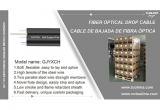.jpg)
In the relentless pursuit of higher bandwidth and lower latency, the fiber optic industry has rightfully celebrated advancements in cable technology. From the debate around transparent fiber optic cables to the critical importance of proper fiber optic installation, the focus has been predominantly on the medium of transmission itself. We meticulously select between single-mode fiber and multi-mode fiber, optimize fiber optic splicing, and guard against macrobending and microbending losses.
Yet, too often, a critical component is relegated to an afterthought: the optical fiber receiver.
Imagine this: You've invested in the highest-grade, low-loss optical fiber. Your installation is impeccable, following every best practice to minimize attenuation in optical fiber. You test the line with an OTDR (Optical Time-Domain Reflectometer), and the results are perfect. But when the system goes live, performance is lacking. You experience packet loss, a higher-than-expected Bit Error Rate (BER), and inexplicable signal degradation.
The culprit? In many cases, it's not the fiber, but the device at the end of the line that fails to accurately convert the stream of photons back into a pristine electrical signal.
From Light to Data: Where the Magic (and Problems) Happen
The journey of a data pulse is remarkable. It travels flawlessly through miles of glass, only to face its most significant challenge at the very end: the optical receiver. This component, typically comprising a photodetector (like a PIN photodiode or Avalanche Photodiode - APD) and a transimpedance amplifier (TIA), is the gatekeeper of your data integrity.
Its job is deceptively simple: detect the weak, high-speed light pulses and convert them into a clean, digital electrical signal. However, this process is fraught with potential pitfalls that can undermine your entire network investment.
The Four Hidden Battles Every Optical Receiver Fights
1. The Sensitivity Challenge
Sensitivity is the minimum optical power required for the receiver to achieve a specified BER. A receiver with poor sensitivity is like a person with poor hearing; even if you shout (send a strong signal), they might miss words. In optical terms, this leads to a short link budget and requires more powerful, expensive transmitters or costly signal repeaters. When evaluating fiber optic communication system performance, sensitivity is a cornerstone metric.
2. The Battle Against Noise
Inside any receiver, electronic noise is the eternal enemy. Thermal noise and shot noise create a constant, low-level "hiss" that can obscure the actual signal. A high-quality receiver is engineered to maximize the Signal-to-Noise Ratio (SNR). When noise wins, the BER increases, leading to retransmissions, latency, and ultimately, data loss. This is crucial for applications like data center interconnects (DCI) and 5G fronthaul/backhaul, where signal integrity is paramount.
3. The Bandwidth Wall
Your network might be equipped for 100G Ethernet or even 400G Ethernet, but is your receiver? A receiver's bandwidth must be sufficient to handle the data rate without distorting the signal. Using a receiver with inadequate bandwidth for a high-speed signal is like trying to pour a gallon of water through a straw—it creates a bottleneck, causing pulse spreading and inter-symbol interference (ISI).
4. The Compatibility Conundrum
Not all receivers are designed to work optimally with all types of fiber. The performance can vary significantly between single-mode fiber and multi-mode fiber applications. Mismatching components or using a generic, low-cost receiver can lead to subpar performance, even with a perfect fiber run.
Beyond the Spec Sheet: The Real-World Cost of a "Good Enough" Receiver
Many system integrators focus on the price point of the receiver, seeing it as a commodity component. This is a costly misconception. The real expense of an underperforming receiver manifests in:
l Increased OpEx: Higher maintenance costs, more frequent troubleshooting, and potential downtime.
l Limited Scalability: A receiver that operates at the edge of its performance limits today will not support future network upgrades, forcing a premature replacement.
l Reputational Damage: For service providers, consistent network issues directly impact customer satisfaction and retention.
The Bridge to the Future: What to Look for in a Next-Generation Receiver
As we push the boundaries of cloud computing, IoT (Internet of Things), and AI-driven networks, the demand on the receiving end of the fiber will only intensify. The next generation of optical fiber receivers must excel in:
l High Sensitivity & Low Noise: Leveraging advanced semiconductor materials and innovative amplification designs.
l Broad Bandwidth Capability: Ready for today's 200G/400G and tomorrow's 800G standards.
l Robust Dispersion Compensation: Integrated capabilities to handle chromatic dispersion and polarization mode dispersion (PMD).
l Power Efficiency: Critical for large-scale deployments in data centers and telecom central offices.
Conclusion: Don't Let Your Investment Vanish at the Finish Line
Your fiber optic infrastructure is a symphony of technology. The cable is the orchestra, playing a perfect score of light. But without a masterful conductor—the optical receiver—the result is dissonance, not data.
Choosing the right receiver is not merely about closing the link; it's about unlocking the full potential of your investment in cutting-edge fiber optics. It is the critical, yet often invisible, component that stands between a signal and successful, reliable data.
Ready to Ensure Your Signal's Journey Ends Successfully?
The discussion around signal integrity is evolving, and the receiver is finally taking its rightful place in the spotlight. At Tuolima, we've been pioneering receiver technology that meets the demands of modern high-speed networks.
While we've explored the critical role of the receiver today, the conversation is about to get more exciting. Next month, we will be unveiling a breakthrough solution designed to redefine performance standards in optical signal reception. We invite you to stay connected with us to discover how you can eliminate the receiver bottleneck for good.
Subscribe to our blog to be the first to access our exclusive November product launch and in-depth whitepapers.
Related Products
IP68 Fiber Optic Splice Closures — Designed to provide secure and reliable protection for fiber optic joints
Aug 02-2024

Enhancing Campus Connectivity: GJYXCH Fiber Optic Cable in Educational Networks
Jan 09-2024

Elevating Urban Infrastructure: GJYXCH Fiber Optic Cable in Smart City Networks
Jan 07-2024